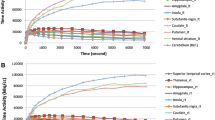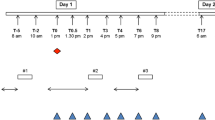Abstract
Rationale
Atypical antipsychotic drugs have been shown to preferentially affect extrastriatal (mesolimbic) D2/D3 receptors over those within the striatum (nigrostriatal). The striatum does not contain exclusively nigrostriatal dopamine tracts, however. The caudate nucleus and ventral parts of the striatum primarily contain limbic and associative dopamine pathways more relevant to psychosis.
Objectives
We tested the hypothesis that two pharmacologically distinct atypical antipsychotic drugs, amisulpride and risperidone, would preferentially occupy of D2/D3 dopamine receptors in limbic and associative regions of the striatum.
Methods
Eight amisulpride-treated patients, six risperidone-treated patients and six age- and sex-matched healthy controls were recruited. Dynamic SPET studies were performed after bolus injection of [123I]epidepride. Binding potential (BP) images were generated using a modified Logan method and aligned between subjects. Regions of interest (ROIs) were placed around head of caudate and putamen bilaterally on an average BP map derived from aligned control images. These ROIs were then applied user-independently to the BP maps for each subject to calculate BP for head of caudate and putamen. Mean occupancy of D2/D3 receptors in each ROI was determined by reference to the drug-free healthy volunteer group. Occupancy values for head of caudate and putamen were compared using paired Student’s t test.
Results
D2/D3 receptor occupancy was 42% in caudate and 31% in putamen for risperidone (t=5.9, df=11, p=0.0001) and 51% in caudate and 37% in putamen for amisulpride (t=11.1, df=15, p<0.0001).
Conclusions
Amisulpride and risperidone both show selective occupancy for limbic and associative D2/D3 receptors within the striatum.



Similar content being viewed by others
References
Bigliani V, Mulligan RS, Acton PD, Ohlsen RI, Pike VW, Ell PJ, Gacinovic S, Kerwin RW, Pilowsky LS (2000) Striatal and temporal cortical D2/D3 receptor occupancy by olanzapine and sertindole in vivo: a [123I]epidepride SPET study. Psychopharmacology 150:132–140
Bressan RA, Erlandsson K, Jones HM, Mulligan RS, Ell PJ, Pilowsky LS (2003a) Optimizing limbic selective D2/D3 receptor occupancy by risperidone: a [123I]-epidepride SPET study. J Clin Psychopharmacol 23:5–14
Bressan RA, Erlandsson K, Jones HM, Mulligan R, Flanagan RJ, Ell PJ, Pilowsky LS (2003b) Is regionally selective D2/D3 dopamine occupancy sufficient for atypical antipsychotic effect? An in vivo quantitative [123I]epidepride SPET study of amisulpride-treated patients. Am J Psychiatry 160:1413–1420
Erlandsson K, Bressan RA, Mulligan RS, Ell PJ, Cunningham VJ, Pilowsky LS (2003a) Analysis of D2 dopamine receptor occupancy with quantitative SPET using the high-affinity ligand [123I]epidepride: resolving conflicting findings. Neuroimage 19:1205–1214
Erlandsson K, Fujita M, Innis RB, Ell PJ, Pilowsky LS (2003b) The effect of lipophilic metabolites on reference tissue modelling of [123I]epidepride SPET data. J Nucl Med 44:254P–255P
Farde L, Wiesel FA, Stone-Elander S, Halldin C, Nordstrom AL, Hall H, Sedvall G (1990) D2 dopamine receptors in neuroleptic naive schziophrenic patients. Arch Gen Psychiatry 47:213–219
Farde L, Suhara T, Nyberg S, Karlsson P, Nakashima Y, Hietala J, Halldin C (1997) A PET study of [11C]FLB 457 binding to extrastriatal D2-dopamine receptors in healthy subjects and antipsychotic drug-treated patients. Psychopharmacology 133:396–404
Flietstra RJ, Levant B (1998) Comparison of D2 and D3 dopamine receptor affinity of dopaminergic compounds in rat brain. Life Sci 62(20):1825–1831
Folstein MF, Folstein SE, McHugh PR (1975) “Mini-Mental State”: a practical method for grading the cognitive state of patients for the clinician. J Psychiatr Res 12:189–198
Gründer G, Landvogt L, Vernaleken I, Buchholz H, Siessmeier T, Ondracek J, Härtter S, Stoeter P, Rousset O, Hiemke C, Roesch F, Bartenstein P (2004) Beyond the striatum: clozapine’s striatal and extrastriatal binding characteristics. Neuroimage 22(Suppl 2):T177–T178
Haber SN (1997) The primate basal ganglia: parallel and integrative networks. J Chem Neuroanat 26(4):317–330
Joel D, Weiner I (1997) The connections of the primate subthalamic nucleus: indirect pathways and the open-interconnected scheme of basal gangliathalamocortical circuitry. Brain Res Brain Res Rev 23:62–78
Joyce JN (2001) Dopamine D3 receptor as a therapeutic target for antipsychotic and antiparkinsonian drugs. Pharmacol Ther 90:231–259
Joyce JN, Meador-Woodruff JH (1997) Linking the family of D2 receptors to neuronal circuits in human brain: insights into schizophrenia. Neuropsychopharmacology 16:375–384
Kapur S, Mamo D (2003) Half a century of antipsychotics and still a central role for dopamine D2 receptors. Prog Neuropsychopharmacol Biol Psychiatry 27:1081–1090
Kapur S, Seeman P (2001) Does fast dissociation from the dopamine d(2) receptor explain the action of atypical antipsychotics?: a new hypothesis. Am J Psychiatry 158(3):360–369
Kessler RM, Ansari MS, Li R, Dawant B, Lee M, Meltzer HY (2002) Occupancy of striatal and extrastriatal dopamine D2 receptors by atypical antipsychotic drugs. J Nucl Med 43:15P
Kish SJ, Shannak K, Hornykiewicz O (1988) Uneven pattern of dopamine loss in the striatum of patients with idiopathic Parkinson’s disease. Pathophysiologic and clinical implications. N Engl J Med 318:876–880
Lammertsma AA, Hume SP (1996) Simplified reference tissue model for PET receptor studies. Neuroimage 4:153–158
Lidow MS, Williams GV, Goldman-Rakic PS (1998) The cerebral cortex: a case for a common site of action of antipsychotics. Trends Pharmacol Sci (19)4:136–140
Logan J, Fowler J, Volkow ND, Wolf AP, Dewey SL, Schlyer DJ, MacGregor RR, Hitzerman R, Bendriem B, Gatley SJ, Christman DR (1990) Graphical analysis of reversible radioligand binding from time–activity measurements applied to [N–11C-methyl]-(−)-cocaine PET studies in human subjects. J Cereb Blood Flow Metab 10:740–747
Marshall V, Grosset D (2003) Role of dopamine transporter imaging in routine clinical practice. Mov Disord 18:1415–1423
Mazziotta JC, Phelps ME, Plummer D, Kuhl DE (1981) Quantitation in positron emission computed tomography: 5. Physical–anatomical effects. J Comput Assist Tomogr 5:734–743
Middleton FA, Strick PL (2000) Basal ganglia and cerebellar loops: motor and cognitive circuits. Brain Res Brain Res Rev 31:236–250
Morisette M, Goulet M, Grondin R, Blanchet P, Bedard PJ, Di Paolo T, Lévesque D (1998) Associative and limbic regions of monkey striatum express high levels of dopamine D3 receptors: effects of MPTP and dopamine agonist replacement therapies. Eur J Neurosci 10:2565–2573
Murray AM, Weihmueller FB, Marshall JF, Hurtig HI, Gottleib GL, Joyce JN (1995) Damage to dopamine systems differs between Parkinson’s disease and Alzheimer’s disease with parkinsonism. Ann Neurol 37:300–312
Piggott MA, Marshall EF, Thomas N, Lloyd S, Court JA, Jaros E, Costa D, Perry RH, Perry EK (1999) Dopaminergic activities in the human striatum: rostrocaudal gradients of uptake sites and of D1 and D2 but not of D3 receptor binding or dopamine. Neuroscience 90:433–445
Pilowsky LS, Mulligan RS, Acton PD, Ell PJ, Costa DC, Kerwin RW (1997) Limbic selectivity of clozapine. Lancet 350:490–491
Reimold M, Mueller-Schauenburg W, Becker GA, Reischl G, Dohmen BM, Bares R (2004) Non-invasive assessment of distribution volume ratios and binding potential: tissue heterogeneity and interindividually averaged time–activity curves. Eur J Nucl Med Mol Imaging 31:564–577
Scherman D, Desnos C, Darchen F, Pollak P, Javoy-Agid F, Agid Y (1989) Striatal dopamine deficiency in Parkinson’s disease: role of aging. Ann Neurol 26:551–557
Schoemaker H, Claustre Y, Fage D, Rouquier L, Chergui K, Curet O, Oblin A, Gonon F, Carter C, Benavides J, Scatton B (1997) Neurochemical characteristics of amisulpride, an atypical dopamine D2/D3 receptor antagonist with both presynaptic and limbic selectivity. J Pharmacol Exp Ther 280(1):83–97
Schotte A, Janssen PF, Gommeren W, Luyten WH, Van Gompel P, Lesage AS, De Loore K, Leysen JE (1996) Risperidone compared with new and reference antipsychotic drugs: in vitro and in vivo receptor binding. Psychopharmacology (Berl) 124(1–2):57–73
Slifstein M, Laruelle M (2000) Effects of statistical noise on graphic analysis of PET neuroreceptor studies. J Nucl Med 41:2083–2088
Sprengelmeyer R, Canavan AG, Lange HW, Homberg V (1995) Associative learning in degenerative neostriatal disorders: contrasts in explicit and implicit remembering between Parkinson’s and Huntington’s diseases. Mov Disord 10:51–65
Stephenson CM, Bigliani V, Jones HM, Mulligan RS, Acton PD, Visvikis D, Ell PJ, Kerwin RW, Pilowsky LS (2000) Striatal and extra-striatal D2/D3 dopamine receptor occupancy by quetiapine in vivo: [123I]-epidepride single photon emission tomography (SPET) study. Br J Psychiatry 177:408–415
Stone JM, Bressan RA, Erlandsson K, Davies G, Ell PJ, Pilowsky LS (2003) Intrastriatal selectivity of atypical antipsychotics: a voxel based analysis. J Psychopharmacol 17:A49
Talvik M, Nordström AL, Nyberg S, Olsson H, Halldin C, Farde L (2001) No support for regional selectivity in clozapine-treated patients: a PET study with [11C]-raclopride and [11C]FLB 457. Am J Psychiatry 158:926–930
Varga J, Szabo Z (2002) Modified regression model for the Logan plot. J Cereb Blood Flow Metab 22:240–244
Vernaleken I, Siessmeier T, Buchholz HG, Härtter S, Hiemke C, Stoeter P, Rösch F, Bartenstein P, Gründer G (2004) High striatal occupancy of D2-like dopamine receptors by amisulpride in the brain of patients with schizophrenia. Int J Neuropsychopharmacol 7:421–430
Walsh FX, Stevens TJ, Langlais PJ, Bird ED (1982) Dopamine and homovanillic acid concentrations in striatal and limbic regions of human brain. Ann Neurol 12(1):52–55
Woods RP, Grafton ST, Watson JD, Sicotte NL, Mazziotta JC (1998) Automated image registration: II. Intersubject validation of linear and nonlinear models. J Comput Assist Tomogr 22:153–165
Xiberas X, Martinot JL, Mallet L, Artiges E, Loc’h C, Maziere B, Paillère-Martinot ML (2001) Extrastriatal and striatal D2 dopamine receptor blockade with haloperidol or new antipsychotic drugs in patients with schizophrenia. Br J Psychiatry 179:503–508
Acknowledgements
R.A. Bressan was supported by charitable research grants from Janssen Pharmaceuticals Inc. and Sanofi-Synthelabo during the data collection. L.S. Pilowsky was a senior clinical research fellow of the UK Medical Research Council (MRC). K. Erlandsson was supported by the UK MRC Senior Clinical Research Fellowship. We declare that the experiments described in this paper comply with the current laws in the UK.
Author information
Authors and Affiliations
Corresponding author
Rights and permissions
About this article
Cite this article
Stone, J.M., Bressan, R.A., Erlandsson, K. et al. Non-uniform blockade of intrastriatal D2/D3 receptors by risperidone and amisulpride. Psychopharmacology 180, 664–669 (2005). https://doi.org/10.1007/s00213-005-2161-2
Received:
Accepted:
Published:
Issue Date:
DOI: https://doi.org/10.1007/s00213-005-2161-2




